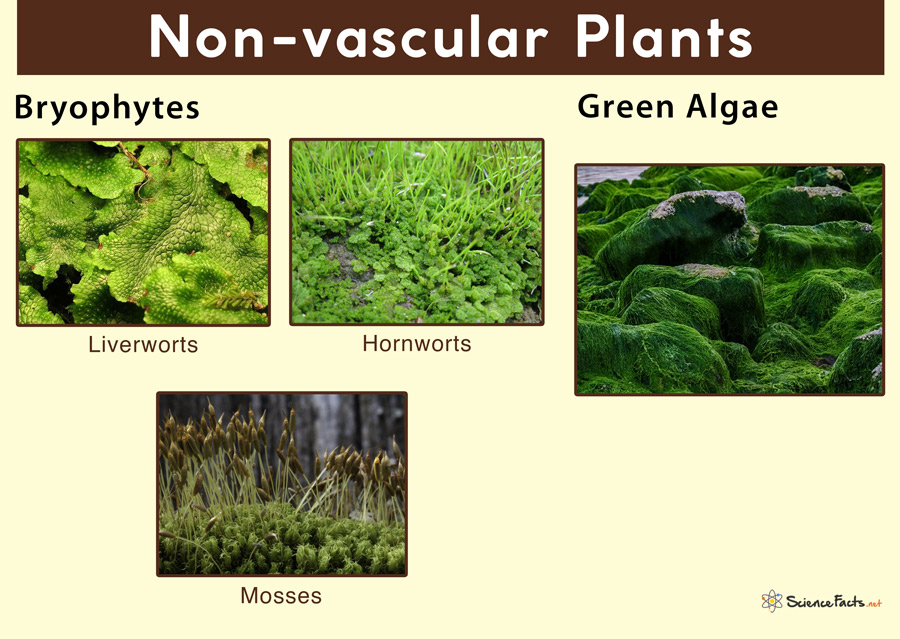Non-vascular Plants
Non-vascular plants are plants devoid of a vascular system consisting of xylem and phloem. They are also devoid of roots, shoots, and leaves and grow from spores. However, some non-vascular plants possess specialized tissues to conduct water and minerals within the plant body.
They include two distinctly related groups: Bryophytes and green algae. They typically appear as small, green mats of vegetation found in damp marshy areas. Despite the prevalence of vascular plants, more than 17,000 species of bryophytes exist on Earth that including mosses, hornworts, and liverworts.
Non-vascular plants were the first plants to evolve. Their small size and lack of vascular tissue systems explain their primitive existence. The first non-vascular plants to evolve were found to be the liverworts. The hornworts evolved next, and mosses evolved last. Among all the bryophytes, mosses are most similar to vascular plants.
Like all plants, non-vascular plants produce and release oxygen in the Earth’s atmosphere, thus helping survive living organisms on Earth. In addition, they also produce various nutrients that are passed to the soil and thus increase soil fertility. They also help reduce soil erosion and provide microhabitats for many animals.
Characteristics
1. Absence of Vascular Tissues
The main characteristics of non-vascular plants are the absence of vascular tissues, the xylem, and the phloem. It means non-vascular plants do not have the mechanism required for transporting food and water at greater heights and thus cannot grow tall like vascular plants. Hence, there is a difference between vascular and non-vascular plants.
2. Habitat
They are commonly found in moist environments. Thus, they are always close to a water source and can absorb the water within the main plant without relying on roots.
3. Absence of Leaves, Root and Shoot System
Most non-vascular plants are small and lack true leaves, seeds, and flowers. Instead of roots, they have a hair-like structure called rhizoids to anchor them to the ground, absorb water and minerals, in addition to leaf-like and stem-like structures. Non-vascular plants also have a lobed leaf-like body called a thallus.
4. Reproduction and Life Cycle
Most non-vascular plants reproduce sexually by creating spores or asexually by vegetative propagation. Vegetative propagation causes part of the plant to break off and develop into a new plant having the same genetic information as the original plant.
Like all plants, reproduction in non-vascular plants involves alternating generations between the diploid (2n) sporophyte stage and the haploid (n) gametophyte stage.
The lifecycle of non-vascular plants is dominated by haploid gametophyte generation. The diploid stage produces spores, while the haploid stage produces gametes or sex cells. The gametophytes appear as green, leafy vegetation that remains attached to the ground or other growing surfaces. In contrast, sporophytes appear as long stalks with spore-containing caps on end. Sporophytes protrude from and are found attached to the gametophyte.
In the presence of moisture, sperm produced by a male gametophyte swim past a layer of rainwater or dew to reach an egg produced by a female gametophyte. Finally, the sporophyte undergoes meiosis to form haploid spores. The spores may also need moisture to disperse.
Classification with Examples
As discussed before, non-vascular plants are classified into two distinctly related groups: the bryophytes and algae.
Bryophytes
There are three divisions of bryophytes: Hapatophyta (liverworts), Anthocerotophyta and (hornworts), and Bryophyte (mosses).
- Liverworts are tiny plants having lobbed, leaf-like, or ribbon-like photosynthetic tissues in place of leaves. They have fine rhizoids, lack stems, and are generally 10 centimeters tall. Liverworts grow in colonies that cover the ground.
- Hornworts are small plants similar in size to liverworts. They also have fine rhizoids and lack stems. The sporophytes in hornworts are long and pointed and rise several centimeters above the gametophyte.
- Mosses are larger plants compared to liverworts and hornworts. They have multicellular rhizoids that are more like roots and have tiny photosynthetic structures, similar to leaves surrounding the central stem-like structure. Mosses grow in clumps to retain moisture.
Green Algae
Not all algae are non-vascular plants. Only those algae found in the clade Viridiplantae, such as green algae, are considered non-vascular plants. It is believed that non-vascular algae led to non-vascular land plants, which led to vascular land plants. However, no scientific evidence supports this theory.
-
References
Article was last reviewed on Monday, March 21, 2022




